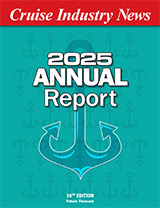Carnival Corporation has reported net income of $194.2 million, or $0.33 per share, on revenues of $989.2 million for its second quarter ended May 31, 2002, compared to net income of $187.0 million, or $0.32 per share, on revenues of $1.08 billion for the same period in 2001.
Earnings for the second quarter of 2002 were reduced by a $9 million loss on the sale of the Nieuw Amsterdam and by $12 million from cancelled cruises.
Carnival attnouted lower revenues year-over-year to lower cruise ticket prices and fewer passengers buying air transportation from the company. This was partially offset by a 2.1 percent increase in cruise capacity.
Also offsetting the lower revenues was a 5.7 percent reduction in the company’s costs per available cruise day due in part to the timing of advertising expenditures, Carnival said.
Gary Cahill, senior vice president of finance and CFO, said in a conference call to analysts that by lowering costs, Carnival had recovered two-thirds of the hit it had taken on yields from lower pricing.
Cahill also attnouted lower net per diems to bookings taken last year and said that otherwise 02 pricing was comparable to 01.
The company reported a load factor of 101.9 percent for its second quarter of this year, compared to 102.5 percent last year.
Net income for the six-month period ended May 31, 2002 was $323.8 million, or $0.55 per share, on revenues of $1.89 billion, compared to net income of $314.9 million, or $0.54 per share, on revenues of $2.09 billion for the same period last year.
Looking Forward
According to Micky Arison, chairman and CEO, booking levels in Q2 were substantially ahead of last year. He added that pricing has largely recovered from the significant discounting of last fall and is now running only slightly below the comparable level of last year.
In addition, Arison said in a prepared statement that on a cumulative basis, advance bookings and average prices for the balance of 2002 remain below last year’s levels, primarily as a result of the dramatic slowdown in 2002 bookings last fall and the shift towards closer-to-sailing booking patterns.
“Based on bookings to date, we expect the trend in yield improvement to continue through the remainder of the year, with net revenue yields to be down three to five percent in the third quarter and slightly up in the fourth quarter,” said Arison.
Also speaking on the conference call, Carnival Vice Chairman and COO Howard Frank said that visibility was quite strong for the third quarter. “We have caught up significantly in bookings in the Caribbean, Alaska and Europe,” he said. “But we are still behind on bookings for the fourth quarter compared to where we were last year at the same time.”
However, Arison and Frank both added that there had been a slowdown in bookings since the end of May, which they attributed to terrorist warnings, the declining stock market, the turmoil in the Middle East, and the tension between India and Pakistan. Arison said that there seemed to be a bit of a slowdown globally.
If nothing happens on 9/11 this year, Arison said that starting 9/12, he expected a significant pick-up in bookings.
Arison also noted that year-over-year comparisons are difficult, since last year at this time, Carnival had very strong bookings.
POC
Frank noted that the U.K Competition Commission’s clearing of the transaction between Royal Caribbean International (RCI) and P&O Princess Cruises (POC) “is seen as extremely helpful to us.”
Frank said that since the regulatory authorities in both the U.K. and Germany had cleared the RCI-POC merger, he saw no reason why the European Commission would hold up Carnival’s proposed takeover of POC. Said Frank: “The EC has historically been supportive of national regulators.”
The European Commission along with the Federal Trade Commission in the U.S. are expected to announce their rulings in August.
Frank said that out of 36 million annual vacations in the U.K., only 747,000 were cruise vacations and that Carnival’s brands held a nine percent market share in the U.K. compared to 10 percent for RCI (so that either transaction would be substantially similar). Frank added that in Germany the “market story was pretty much the same.”
Carnival executives would not comment on any strategy they may be entertaining if necessary to fulfill regulatory demands in order to complete the deal.
New Ships
“We see no compelling reason to order new ships right now,” said Frank, pointing to increased building prices as a result of the rising value of the euro. “That is not to say we will not order in the future,”· he added. “We will be patient and wait for the right time and the right price.”
As to the possibility of building in Asia, Arison said that he had “no interest in building ships in the Far East.”
Meanwhile, Carnival has ships on order for deliveries through 2006. This fall, Carnival Cruise Lines will take delivery of two ships, including its largest ship ever, the 2,974-passenger Carnival Conquest. while sister company Holland America Line (HAL) will also take delivery of its largest ship, the 1,848-passenger Zuiderdam.
Accumulating Cash
What will Carnival do with all the cash the company generates if it does not build new ships or acquire POC? Answered Cahill: “We always look at return on invested capital. So far it has always made more sense to invest in ships.
“It will not become an issue before late 04 or 05. We will look at it then,” Arison said.
Added Frank: “We think it is better to sit on significant cash. You never know.” To which Arison commented: “If you are in the travel industry, you would want to have a balance sheet like ours.”
Brand Performance
Commenting on individual brands, Frank said that Carnival was performing rather well, as was expected, but that HAL was not performing as well, which he attributed to its longer cruise programs and different passenger demographics, which are impacted more by political and economic instability.
Arison added that HAL had also been impacted by a reduction in capacity so far in 2002 with the Westerdam going to Costa Crociere, which was only partially offset by the arrival of the smaller Prinsendam.
Arison also said that Cunard Line has shown a strong recovery in 2002, which he attributed to a new organization and a new management team. Cunard did poorly in 2001, he said. The Seabourn Cruise Line brand is also performing extremely well with occupancies running 98 percent at higher prices for the fourth quarter, according to Arison.
Meanwhile, Windstar Cruise is not performing anywhere nearly as well, which Arison attributed to ship deployment and different passenger demographics.
Cahill noted that the tour operations lost money in the second quarter and generally are only profitable in the third quarter. “It is there to support the cruises,” he said.
2003
Frank said it was too early to comment on 03 but that he would be prepared to do so in September or October.
Arison, however, added that competing cruise lines had made some “strange” deployments for next year resulting in huge capacity increases in certain markets.
He cautioned that there may be “some dramatic competitive swings” in regional markets, noting the movement of ships back to Europe, which he said had not stabilized yet.
“We moved one HAL ship out of Europe this year and it is not going back next year,” Arison said. “We also moved one Seabourn ship out which is going back next year. But it has only 204 beds.
“But some companies are increasing their European capacity by 100 percent or more in 2003,” Arison said, adding that the conditions in the Eastern Mediterranean may be even worse now than before.



